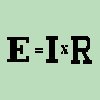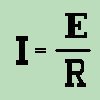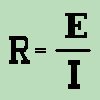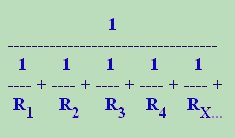


Formula ReviewIn Review, the formula for finding Resistance, Voltage, and Current within a circuit (Ohm's Law) is:  or or  or or  Much Akin to it is "Ohm's Watts Law" for finding POWER The Formula for finding the TOTAL RESISTANCE (or inductance in the case of a coil) in series is The Formula for finding the TOTAL CURRENT in series is  CURRENT NEVER CHANGES in a series circuit!!! In short - if you can measure the current ANYWHERE within the series circuit - you know the current in the whole circuit! (Very handy when checking Christmas lights) The Formula for finding the TOTAL RESISTANCE in a parallel circuit is  The Formula for finding the TOTAL CURRENT in parallel is The formula for Time and Frequency is The formula for Peak vs Effective voltage is: RED? REALLY? Ok, perhaps I have stressed this point a bit too far, but then again, in electronics, and especially in radio electronics, you will see this formula again and again. Inductive reactance constitutes the resistance seen by an AC circuit when it runs into a coil. Sometimes, an inductor is called a CHOKE, because it chokes an alternating current flow. In power supplies, you may find a FILTER CHOKE, which opposes any ac frequencies, while allowing DC to pass through unharmed. Its purpose is to clean up the power supply voltages, so that no noise is seen on the power - just a clean DC source. There are both audio frequency chokes (AFC) and radio frequency chokes (RFC). Another point, which I passed over previousely, is that there are several types of "RESISTANCE" found in AC electronics, some of which will be negligable, others you will find fascinating and extremely important to the study of electronics. I will try to cover in detail the important ones. I will also, (when I remember to) mention the lesser important ones, as I will at this time. RELUCTANCE is a form of resistance which we have not discussed yet. The reason for not discussing it, is that in most electronic applications, you can pretend that it doesn't exist. Reluctance is actually the resistance, not to the flow of current, but to any MAGNETIC FIELD which cuts through any pre-existing magnetic field. To some small extent, this happens in all coils operating at AC, due to Self Inductance, or by way of Mutual Inductance. Mathematically speaking (oh no!) we say that it is equal to the MAGNETOMOTIVE FORCE / MAGNETIC FLUX, or that it is the reciprocal of PERMEANCE. Now, don't you feel safer? Isn't your life better, since you have learned that bit of trivia? |
| (On The Following Indicator... PURPLE will indicate your current location) | ||||||||||||||||||||||||
| 1 | 2 | 3 | 4 | 5 | 6 | 7 | 8 | 9 | 10 | 11 | 12 | 13 | 14 | 15 | 16 | 17 | 18 | 19 | 20 | 21 | 22 | 23 | 24 | 25 |
| 26 | 27 | 28 | 29 | 30 | 31 | 32 | 33 | 34 | 35 | 36 | 37 | 38 | 39 | 40 | 41 | 42 | 43 | 44 | 45 | 46 | 47 | 48 | 49 | 50 |
| 51 | 52 | 53 | 54 | 55 | 56 | 57 | 58 | 59 | 60 | 61 | 62 | 63 | 64 | 65 | 66 | 67 | 68 | 69 | 70 | 71 | 72 | 73 | 74 | 75 |
| Otherwise - please click to visit an advertiser so they know you saw their ad! |
